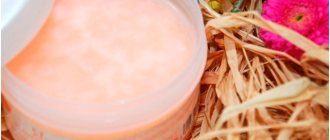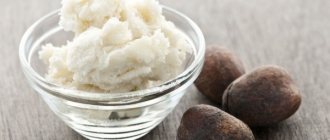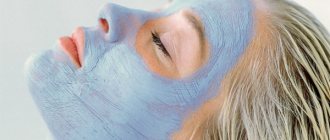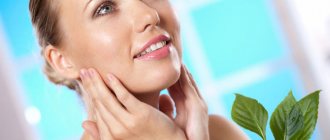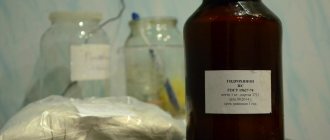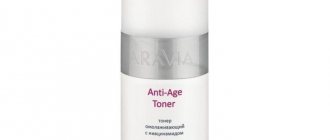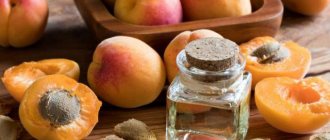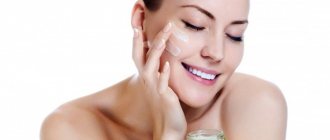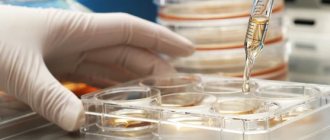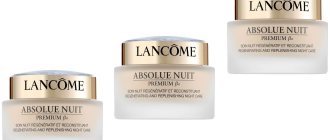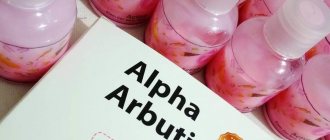Name : Hyaluronic acid
INCI : Hyaluronic Acid
Trade names : Sodium Hyaluronate/Hyaluronic Acid, Hyaluronic Acid-Bt, Sodium Salt Hyaluronic Acid, Healon.
Recommended dosages : 0t 0.1 to 3%
Description of the component : Hyaluronic acid is a white hygroscopic powder that swells in water. Has no smell. Presented in several types: high molecular weight hyaluronic acid and low molecular weight hyaluronic acid. Each type is used for different purposes.
Sodium hyaluronate and hyaluronic acid
Sodium hyaluronate is used in cosmetics along with hyaluronic acid. What distinguishes these humectants is their molecular size. Sodium hyaluronate is a low molecular structure, i.e. it is a structural component of hyaluronic acid and therefore has a much smaller molecular size.
This property of sodium salt allows it to penetrate deep into the skin and not settle on the surface. Low molecular structure is usually used in cosmetic products: creams, emulsions, masks, lotions. Cosmetics with sodium hyaluronate act from the inside.
Hyaluronic acid is a high molecular structure.
Its molecules are quite large in size, so they cannot penetrate deep into the epidermis and settle on the surface, thereby exerting their effect directly on the skin.
The high-molecular structure is usually used in professional fillers - beauty injections for mesotherapy or biorevitalization, the main purpose of which is to fill wrinkles and smooth them out. The most effective, according to experts, is the use of both types of hyaluron.
Safe substances
Water (Aqua)
Typically, this component always comes first in the ingredients of any cosmetics. It is needed to dissolve the remaining components, create a certain texture and fill the package. This is an excellent base that does not affect the effectiveness of the composition.
Sodium Hyaluronate
One of the most commonly used components in cosmetics. It is he who creates a light film on the skin that draws moisture from the air and fills the stratum corneum with it. Water is retained in this layer of the dermis, and we feel a moisturizing effect.
Glycerin
This is one of the top moisturizing components (along with hyaluronic acid and serine). Moreover, it is the cheapest of all if it is a by-product of the food industry.
But there is also expensive, organic glycerin, which is made specifically for cosmetics from organic vegetable oils.
Urea (Urea pura)
This component is often used in creams for people suffering from atopic dermatitis. Its advantage is that it penetrates well under the skin and enhances the conductivity of other elements - both beneficial and harmful.
Oils
If you find natural oils from the list below in cosmetics, this is considered a good sign.
- Shea butter
- Argan (Argania Spinosa Oil),
- From rice bran (Rice Bran Oil),
- Baobab Seed Oil,
- Grapes (Vitis vinifera L. Grape Seed Oil),
- Evening Primrose Oil,
- Rosehip (Rosa Canina Oil),
- Borage (Borago officinalis L. Oil).
These are components that replenish the deficiency of essential linoleic and linolenic fatty acids in the skin, and fight dry skin and flaking.
Tocopherol acetate
This complex name hides the notorious vitamin E. It dissolves in fats and prevents the oxidation of the product. Tocopherol acetate is added to cosmetics because it preserves the product well and allows the use of fewer components responsible for long-term storage of cosmetics.
Retinol
One of the most famous ingredients in cosmetics, the love for which has already become a religion for many. But it can be toxic even in small doses, so its use must be strictly regulated. Retinol is actually a form of vitamin A.
This component is highly photosensitivity, which means that exposure to the sun can provoke the formation of age spots. Therefore, it is important to use any cosmetics with retinol only in combination with a cream with SPF 15 or higher.
Panthenol
This is provitamin B5. Helps in the synthesis of new skin cells. It will be useful for burns, cuts and other skin damage.
Vitamin C
This component is often used in anti-age cosmetics because it stimulates collagen synthesis. It also whitens the skin well. At the same time, vitamin C is quite difficult to stabilize; it oxidizes easily, so manufacturers often produce products containing it in opaque packaging.
Ceramides
Look for it in the composition if you have dry, problematic or sensitive skin. It helps restore the protective barrier of the epidermis, as well as lecithin (Phosphatidylcholine), natural moisturizing factor (NMF) and phytosterols.
Antioxidants
Essential substances for the skin – we’ll tell you about the most famous ones.
- Green tea (Camellia Sinensis Leaf Extract),
- Grape extract (Vitis vinifera Extract),
- Centella asiatica / gotu kola (Centella asiatica Extract).
Hyaluronic acid
The substance is absolutely safe in creams and masks. The effect in cosmetics has nothing to do with what occurs after injections. The cream with the component creates a film on the skin and helps it not lose moisture.
Benefits of using sodium hyaluronate
The main property of sodium salt is to retain moisture in the skin structure and attract it from the external environment, which generally has a beneficial effect.
This:
- helps moisturize the skin;
- stimulates the work of fibroblasts;
- slows down the natural aging process;
- prevents the formation of wrinkles, smoothes out shallow ones;
- eliminates inflammatory processes in acne and acne;
- delivers nutrients to the deep layers of the epidermis;
- protects the skin from adverse environmental influences.
Who is suitable for cosmetics with hyaluronate?
Creams and other products based on sodium hyaluronate are suitable for any age. However, cosmetologists recommend using such products starting from 25 years of age. It is at this age that the skin begins to lose hyaluronic acid and along with it the moisture necessary for the epidermis.
After 35 years, these processes worsen, so you cannot do without creams, masks and other cosmetics based on hyaluronate.
This component will prevent the aging of the skin and prolong its youth. After 50 years, it is better to combine hyaluronic cosmetics with professional cosmetic procedures with the same ingredient. Then the skin will not only receive the necessary hydration, but will also smooth out and become more toned.
In addition, such cosmetics are suitable for any skin type:
- dry – active moisturizing;
- combined – relief of inflammatory processes;
- oily – removal of excess oily secretions.
In what areas is the substance used?
Sodium hyaluronate and its properties began to be actively studied around the middle of the twentieth century. It was found that hyaluronic acid has an unusual ability to restore and regenerate. They are renewed daily, but regeneration slows down as the body ages or when hormonal levels change.
The chemical composition of hyaluronate is capable of changing its chemical composition when there are pathologies inside the body. As a result of this research, fruits were obtained that help recognize the presence of some serious diseases. For example, if there are joint diseases, then the internal composition of this acid changes.
Therefore, drugs containing this substance are often prescribed for joint diseases, because such drugs can restore joint tissue, help with muscle disorders and when their tone decreases. It follows from this that the benefits of hyaluron are not only for the skin.
Hyaluronic acid is also useful in cases of damage to connective or nervous tissue. In addition, it is also used in the field of ophthalmology. It is used in the treatment of the retina of the eye, since it is present in its pure form in the lenses of the eye. In view of this, this substance helps very well after surgery.
Sodium hyaluronate in cosmetics
Facial care products based on the component in question can be divided into the following areas of use:
- to maintain tone, prevent wrinkles, moisturize and soften, creams and lotions with 0.1% -1.0% sodium salt content are suitable;
- for rejuvenation, transportation of nutrients, prolongation of the action of other products, it is worth choosing products with a content of 2.0% sodium hyaluronate;
- to protect the skin from sun rays and other adverse factors - with 1.0% sodium salt.
Please note that cosmetics based on sodium salt should not contain alcohol, parabens, sulfates and other dangerous ingredients that adversely affect the skin.
Librederm
Cosmetics from Librederm with sodium hyaluronate are considered one of the most effective.
A series of cosmetics is aimed at restoring various skin types:
- dry skin will receive the necessary hydration and gain radiance;
- combined – restoration and normalization of water balance, relief of inflammatory processes;
- oily – normalization of oily secretion, reduction of oily sheen.
Products from Librederm based on hyaluronate and camelina oil rejuvenate the skin, prevent the formation of wrinkles, the turgor becomes tightened and clearer.
The HYALURONIC collection includes the following products:
- foam for washing;
- day and night creams;
- eye cream;
- mask;
- activator serum.
Librederm products do not contain parabens, are not cytotoxic, and have a high level of tolerability. The cost of cosmetics starts from 500 rubles. On the manufacturer’s website you can choose gift sets (at least 3 products), the price of which starts from 2000 rubles.
Evelyn
New Hyaluron New generation (30+-60+) from Eveline provides the necessary skin care starting from the age of 30:
- protects against moisture loss;
- saturates cells with the necessary amount of fluid;
- smoothes wrinkles;
- improves turgor and elasticity;
- protects against ultraviolet radiation;
- provides additional care depending on age.
The skin is rejuvenated, facial contours become clearer. Overall, the skin looks refreshed and rested.
The New Hyaluron collection consists of the following products:
- day/night cream;
- gel filler for the eye contour;
- gel mask.
Products from Evelyn are suitable for any skin type, the main thing is to buy the product in your age category:
- 30+ — moisturizing the epidermis, preventing early aging;
- 40+ — promotes cell regeneration, hydration;
- 50+ — deep skin rejuvenation with hyaluronate, stem cells and calcium;
- 60+ - intense hydration and lifting effect, comprehensive skin care.
The cost of products with sodium salt from Evelyn starts from 200 rubles. for 1 product.
D'Oliva
Sodium hyaluronate in D'Oliva cosmetics provides the skin not only with the necessary hydration, but also with visible rejuvenation: it becomes elastic, soft and delicate, its color is evened out.
The collection of products with hyaluronate from D'Oliva includes:
- day/night moisturizer;
- active corrector of deep wrinkles;
- gel for the skin around the eyes;
- moisturizing mask.
In addition to sodium salt, the products contain:
- vitamin E (natural antioxidant);
- Shea butter;
- olive oil;
- panthenol.
D'Oliva cosmetics are considered medicinal and therefore are sold in pharmacies. The cost of products starts from 600 rubles.
Merz Special
Merz Spezial cream mousse with hyaluronic acid contains 6 main active ingredients that are ideally combined with each other:
- sodium hyaluronate;
- marine glucosamine;
- brown algae (extract);
- aloe leaf gel;
- shea butter;
- oat grain (chopped).
The action of the components gives a visible result:
- 100% hydration and protection against dryness;
- rejuvenation of the epidermis;
- the number of wrinkles is reduced by more than 70%.
The skin becomes smooth, soft and radiant. The structure of the cream is light and weightless due to the form used - mousse. The product applies well, absorbs quickly, and is suitable as a base for makeup. Use the cream in the morning. For night care, the Merz Special company suggests using a cream with collagen.
Also, for a more lasting and pronounced result, it is recommended to use Merz Classic Special Dragee. The cost of cream with hyaluronic acid is 800 rubles.
Mizon
The Korean brand Mizon has proven itself well in the Russian market, with a cream based on sodium salt – Intensive Skin Barrier Cream – being especially popular. The product contains natural ingredients: cocoa extract, European olive, fruit oils and others. Does not contain alcohol.
Action of the cream:
- moisturizes and protects against moisture loss;
- smoothes out shallow wrinkles;
- rejuvenates the skin.
The product is easy to apply, does not leave a greasy shine, and does not clog pores. It is used economically: the package will last for 2–3 months. The cream is ideal for dry and normal skin, especially during the cold season. The cost of cream from Mizon is 1500 rubles.
Role in the human body
Hyaluronic acid is one of the main components of the intercellular substance, so it can be found almost everywhere in the body.
The largest concentration of hyaluronic acid is found in the skin, but it is also present in cartilage tissue, the vitreous body of the eye, and the umbilical cord. This substance has unique properties, which explains its widespread use in various drugs. These properties include:
- creating a physiological environment for cell division and differentiation, as well as optimal conditions for normal cellular and tissue homeostasis;
- ensuring the removal of waste products, as well as the transport of nutrients from vessels to cells, which promotes drainage and detoxification of tissues;
- providing an immunomodulatory effect, increasing tissue resistance to free radical effects;
- ensuring tissue regeneration and eliminating damage (plastic function);
- participates in the synthesis of collagen and elastin;
- is an important substance in regulating processes during embryo development;
- has antiviral activity;
- is a participant in creating intradermal pressure, while maintaining turgor and ensuring skin elasticity by creating additional moisture for the dermis and epidermis layers;
- helps reduce endogenous intoxication rates;
- helps to activate bactericidal properties on the surface of the skin and resist the further spread of bacteria;
- helps prevent the formation of scar tissue and uniformly fill defects with newly formed tissue.
In human skin, sodium hyaluronate contains about 50% of the amount found in the body. Considering that the skin is 70% water and is renewed quite quickly, then this substance is very important for maintaining the structure of the skin. Hyaluronic acid is essential for daily renewal and recovery.
In addition, it has a high ability to retain moisture. One molecule of acid can bind 200−500 molecules of water. In view of this, the dermal layer, which contains a fairly large amount of acid, is saturated with water, which ensures elasticity and resistance to external influences.
Use at home
It is not by chance that sodium hyaluronate is used in cosmetics, because it is part of the skin and helps maintain its youth and beauty. However, it is not necessary to buy expensive branded products with this component. Sodium salt is sold in the pharmacy in the form of a white powder and can be used to make homemade creams and masks.
The cost of 5 g of powder in a pharmacy is about 200 rubles.
Cream with sodium hyaluronate
To make homemade cream you will need the following:
- hyaluronate powder – 5 g;
- distilled water;
- face cream suitable for your skin type;
- any vegetable oil;
- essential oil;
- liquid vitamins A and E.
The main component is mixed with water (20–30 ml) until a homogeneous consistency without lumps is formed, and put in the cold for several hours. Then add 1 tsp. selected cream and 2 drops. vegetable and essential oils, vitamins. The mass is thoroughly mixed. If the mixture turns out to be runny, you can add a little more of the chosen cream.
Sea buckthorn, olive, linseed, and essential oils such as ylang-ylang, bergamot, geranium, and rose are suitable as vegetable oils. The finished cream must be transferred to a clean pasteurized jar and closed with a lid. The product should be stored in the refrigerator, but no more than 4 days. It is recommended to use homemade cream at night on the face, neck and décolleté. Course – 10 days.
Please note that before using the product you should do an allergy test by applying it to sensitive areas of the skin.
Sodium hyaluronate is a must in facial cosmetics.
If the product is allergenic, it should not be used. You can also add sodium salt to your favorite cream before applying it: 1-2 drops. liquid emulsion for 1 serving of cream.
Substances that may be dangerous
Lauryl sulfate and sodium laureth sulfate (Sodium Lauryl Sulfate - SLS and Sodium Laureth Sulfate - SLES)
These are well-known surfactants (surfactants). They are obtained from coconut oil and are widely used in everyday life for washing floors and cars. Most often in cosmetics they can be found in shower gels, bath foams, shampoos, toothpastes and other detergents.
Quite inexpensive components that are added to make cosmetics foam. At the same time, SLS and SLES can dry out the skin without removing the secreted oil from it. Such ingredients in the composition often cause irritation and itching.
Propylene Glycol
In industrial production it is used as antifreeze in water cooling systems or as brake fluid. Propylene glycols in cosmetics should be up to 5% (these are international standards).
Polyethylene glycol (PEG)
In beauty products, substances with the PEG prefix are added to moisturize (for some time after using a product with such a component in the composition, you can actually feel the smoothness of the skin) and dissolve other components.
But subsequently the substance draws moisture and other important components from the skin. In addition, polyethylene glycol is a provocateur for sensitive skin. If you see PEG in the list of ingredients, know that the manufacturer decided to save money in this way.
Butylene Glycol
He can often be found at the beginning of a lineup. It is considered a potential irritant and may cause skin sensitivity.
Mineral and paraffin oil (Mineral oil, Petrolatum)
These are petroleum products. These components clog pores, slow down the synthesis of new cells, draw fluid from the skin and reduce barrier function.
Mineral oil most often provokes acne and allergic rashes. Paraffin oil forms a film on the skin that makes it unable to breathe.
Dimethicone
This is silicone - a component thanks to which the product lies on the skin in an even layer and gives a feeling of lightness and smoothness. It is greasy and sticky, and in small quantities it is not harmful.
Its comedogenicity is a matter of purely individual reaction. However, it is not suitable for organic cosmetics because it does not decompose in the environment.
Alcohol / Ethyl Alcohol (Alcohol / Alcohol Denat)
This substance disinfects, but at the same time promotes drying of the skin. In cosmetology, alcohol is used as a stabilizing and emulsifying component.
Parabens (Propylparaben, Methylparaben, Butylparaben)
They can be found in toothpastes, deodorants, shampoos and intimate lubricants. Manufacturers add them as preservatives. 20 years ago they wanted to ban them. But so far there are no reliable studies proving that parabens cause breast cancer, but many experts tend to believe it.
Diethanolamine and triethanolamine (DEA and TEA)
These components can be found on the “black” lists of substances used in cosmetics. DEA and TEA are used to regulate acidity levels and create foam. They also strip the skin, while drying it out and causing irritation. When interacting with nitrates, they form carcinogens.
Phthalates
They are found in moisturizers, lotions, nail polishes, deodorants and perfumes. In European countries, most phthalates have been banned because they cause disruption to the endocrine and reproductive systems.
Polyquaterniums
Like silicones, these substances accumulate in the skin and hair and have an irritating effect.
12. Formaldehyde releaser (2-bromo-2-nitropropane-1,3-diol, 5-bromo-5-nitro-1,3-dioxane, Diazolidinyl urea, DMDM Hydantoin, Imidazolidinyl urea, Sodium hydroxymethylglycinate, Quaternium-15)
If the label states that it contains “no parabens,” this does not mean that the product is safe. Often parabens are replaced with another preservative - formaldehyde releaser. It is important to understand that due to proven toxicity, its progenitor - formaldehyde - was completely banned in cosmetics, and the concentration of formaldehyde releaser should not be higher than 0.2%.
Methylisothiazolinone
This is a preservative that can be found in shower gels, shampoos and face creams. If the amount of a substance exceeds the permissible limits, it can cause allergic reactions and even contact dermatitis. Back in 2002, its toxicity was proven. In the European Union, methylisothiazolinone has been banned for use in all leave-in cosmetic products for several years.
Sodium hyaluronate mask
Recipes for face masks with sodium hyaluronate:
- Dilute 2 g of powder of the main component with 1 tbsp. distilled water until smooth. Apply to skin and leave until completely absorbed.
- Mix 1 g of hyaluronate with 30 g of nicotinic acid, dilute with distilled water to form sour cream. Apply to problem areas and wait until completely dry.
- Mix 30 g of quinine, 2 g of sodium salt powder, 30 g of zinc oxide, 45 g of glycerin. Dilute the mixture with water and leave until thick. Apply to face and wait until completely dry.
- Mix 3 beaten egg whites with 25 ml of lemon juice, add the zest of 2 small lemons, 40 g of oatmeal, 3 g of hyaluronate. It is recommended to remove the remaining mask with a warm compress.
- 1 g of powder of the main component, 0.5 tbsp. distilled water, 0.5 tsp. glycerin, 1 green tea bag, 3 drops. lavender oils. You need to boil water and brew green tea in it, let it cool. Add powder, mix well. Add remaining ingredients. Pour the resulting mixture into a bottle and shake everything well. Apply to face and leave until completely absorbed.
It is recommended to make masks no more than 1–2 times per week for 10–12 weeks.
Cosmetics with hyaluronic acid
Doppelhertz
Vitamin complexes containing sodium hyaluronate are available in the form of capsules or tablets and create a lifting effect.
The Doppelhertz lifting complex has high properties, which contains, in addition to acid, beta-carotene, vitamins, selenium and zinc. Doppelhertz improves complexion, protects the skin from the effects of the external environment and has an antioxidant effect. For adults, it is recommended to take one capsule of the drug with meals. The general course of treatment is one month, followed by a month break.
Juvederm
Among all fillers, Juvederm is considered the most popular, since it contains hyaluronic acid of non-animal origin. This helps reduce the risk of an allergic reaction or side effect several times. The substance can be injected into the superficial, middle or deep layers of the skin.
Each Juvederm product contains lidocaine, so there is no need for painkillers during the procedure.
Injections are used to smooth out nasolabial folds, smooth out facial contours, enlarge lips and fill wrinkles. The effect lasts for 5-8 months, depending on the area of injection.
Libriderm
Popular cosmetics with sodium hyaluronate include Libriderm cream, which has a light texture and a high acid content.
It can be applied to the décolleté, face and neck as it intensely moisturizes and nourishes the skin and helps fight the signs of aging. After regular use of the cream, the microrelief improves, a natural glow appears, the complexion improves and the skin becomes smoother. Tip: Choosing a product or procedure using hyaluronic acid depends on the individual problem and the desired result. You can get the maximum effect only by administering subcutaneous injections.
Sodium hyaluronate mask
In order not to spend a lot of money on trips to expensive beauty salons or on preparations with hyaluronic acid, you can prepare a healthy mask or cream yourself at home. It should be remembered that it will not be possible to achieve the same effect as during injections, because such products can only act on the surface layer of the skin.
A mask with hyaluronic acid will help eliminate fine wrinkles, change your complexion for the better and provide the skin with good hydration.
To prepare it you will need the acid itself or a salt of the acid with sodium. You can buy these components in city pharmacies or order through an online store.
Sequencing:
- It is necessary to measure 2 g of hyaluronic acid powder and dilute with 30 ml of boiled warm water;
- All components should be thoroughly mixed and left until completely swollen for one hour;
- If lumps appear, you need to knead them thoroughly and then apply the finished mask to a face cleansed of cosmetics;
- The mask is applied in a thin, even layer over all surfaces of the skin and remains until completely absorbed. No need to rinse off.
To obtain maximum results, about 11 procedures are necessary.
Advice: Before using hyaluronic acid, it is advisable to see a doctor in order to exclude the presence of direct contraindications.
Contraindications for use
Sodium hyaluronate is a natural constituent of the skin. At the same time, its analogue of animal or chemical origin may be added to cosmetic products; accordingly, an allergic reaction may occur to this component.
Also, products based on sodium salt are not recommended:
- while expecting a child;
- during lactation;
- during exacerbation of chronic diseases;
- in the presence of inflammatory processes on the skin;
- after chemical peeling.
Self-prepared masks and creams must be checked for allergic reactions. In addition, it is recommended to comply with all proportions specified in the recipes so as not to exceed the permissible percentage of hyaluronate indicated for home use - no more than 2%.
Properly selected cosmetics based on sodium hyaluronate will help preserve the youth and beauty of the skin, moisturize the epidermis, and protect against external adverse factors.
Article design: Anna Vinnitskaya
